I finished my first aircraft kit for a number of years recently (the 1/72 Airfix Mitsubishi A6M2b Zero, as you ask) and I enjoyed it so much I thought I’d try another small scale aircraft. Although Airfix was the mainstay of my childhood kit-building, Revell kits also featured widely. I have attempted a couple of Revell 1/72 tank kits in the last couple of years, and they were both pretty good. So when I noticed that Revell also do a budget range of 1/72 aircraft kits, I thought I’d take a look. Here in Spain, these sell for around €8, which is about as cheap as it gets for any plastic kit, but are these bargains or just cheap and nasty?
The answer seems to be that these kits are a mixed bag. All are the same price, but some are rather elderly: the Ta-152, for example, appears to be a re-box of a FROG kit initially released back in 1968 and the P-51D and Fokker D VII date all the way back to original Revell releases in 1963. As you’d expect, these older kits just aren’t up to modern standards but some of this budget line are more recent releases and seem to be well regarded. The P-47M Thunderbolt, for example, was released in 1999 and looks pretty good. If you’re going for one of this range, you do need to do a little research to understand what you’ll be getting.
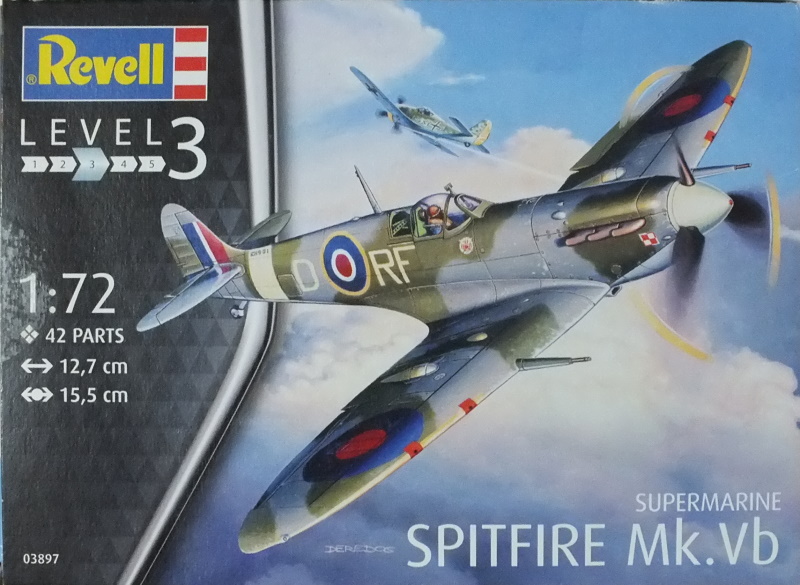
Revell first released a 1/72 Spitfire kit (covering the Mk I) all the way back in 1963. Then, in 1996 they issued a new-tool Spitfire Mk Vb that was, to be honest, a bit crap with a number of notable accuracy issues. My choice here is yet another new-tool kit of the Spitfire Mk Vb released by Revell in 2018. Reviews suggest that this is much better than the 1996 version, though I believe both are still available so if you’re thinking of buying one, make sure you get the 2018 kit (03897) and not the version from 1996 (04109).
I’d guess that there can’t be many kit-builders who haven’t attempted a small-scale Spitfire at some point so I’ll be interested to see how this relatively recent Revell kit stacks up.
History
In 1930 the British Air Ministry issued Specification F.7/30 which called for designs for a new fighter capable of 250mph and armed with four machine guns. Several companies responded including Supermarine Aviation Works, a subsidiary of Vickers. The outcome was an entirely new monoplane, the Supermarine Type 224. Unusually, the company asked the Air Ministry to reserve a dramatic new name for the new aircraft (if it was accepted into service): Spitfire.
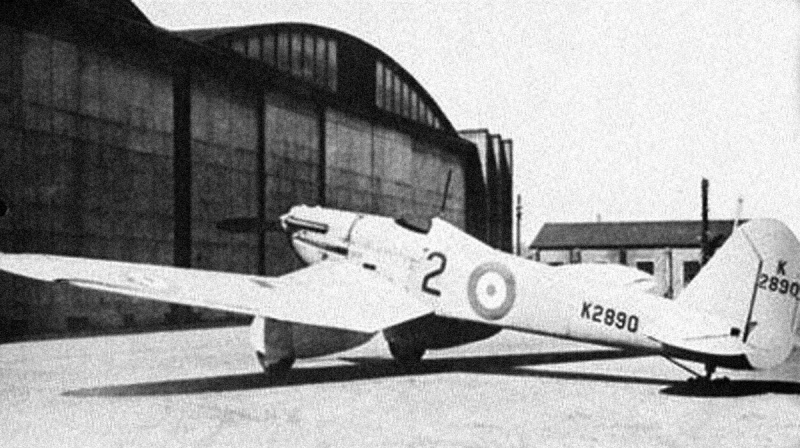
Supermarine Type 224. Horrible, isn’t it?
The outcome was a single prototype Type 224 built in 1933. It was a truly ugly monoplane with thick gull-wings, an open cockpit and fixed undercarriage provided with spats. It was powered by the unreliable Rolls-Royce Goshawk II engine (the thick wings and spats incorporated the complex cooling system for the engine) and was capable of no more than 235mph. Overall the Type 224 looked more like a Junkers Ju-87 Stuka than a sleek fighter and it never went into production (or received the name Spitfire). Even Supermarine’s chief engineer, Reginald Mitchell, was disappointed and he immediately began work on something radically different, a streamlined monoplane with an enclosed cockpit and retractable landing gear. The outcome of this second design led to the incomparably better Supermarine Type 300.

Prototype of the Supermarine Type 300 preparing for its first test flight.
Powered by the new Rolls-Royce PV-12 engine (soon to be named the Merlin) the new aircraft made its first flight in March 1936. The thin wings were of a unique elliptical shape and featured a cantilevered main spar that gave immense strength while allowing internal space for the undercarriage, eight Browning machine guns and over 2,400 rounds of ammunition. The fuselage was of monocoque construction, with the thin outer skin giving added strength. It’s performance was simply outstanding, giving good speed and manoeuvrability while remaining relatively easy to fly.

An early Mk I Spitfire with two-blade propellor.
It would be 1938 before the first production aircraft finally left the Supermarine works in Southampton, now formally named as the Spitfire. Mitchell commented that this was a “bloody silly name.” Apparently, he wanted the new aircraft to be called the Supermarine Shrew! Over the next 15 years, the Spitfire would go through more than 20 variants and over 22,000 were built in total.
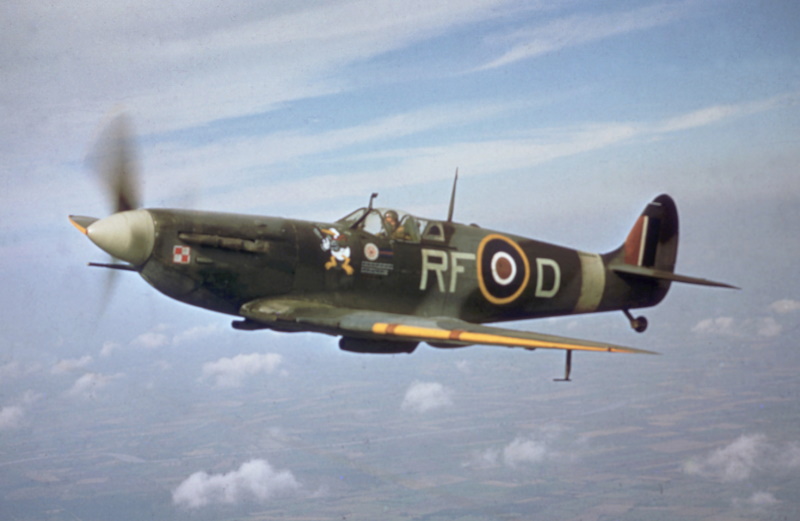
A rare colour wartime image from 1943 of the subject of this kit, the Spitfire Mk Vb flown by Squadron Leader Jan Zumbach of 303 Kosciuszko Polish Fighter Squadron.
The subject of this kit is the Spitfire Mk Vb. The Mk V was the first major upgrade to the Spitfire as a day fighter (the MK II was very similar to the original version, only a single Mk III prototype was produced and the Mk IV was produced only as an unarmed photo-reconnaissance version). The main difference in this version was the provision of a more powerful Merlin 45 engine fitted with a single-stage, single-speed supercharger for improved low altitude performance and a new carburettor capable of maintaining fuel flow to the engine under negative G. There were three main versions of the Mk V: the Va, armed with eight Browning machine guns, the Vb, armed with four machine guns and two 20mm cannon and the Vc, provided with wings that could be armed with either eight machine guns, four machine guns and two 20mm cannon or four 20mm cannon.

Another colour wartime image showing Squadron Leader Jan Zumbach (wearing life-jacket) standing in front of his Spitfire Mk Vb.
This was the most produced of all Spitfire versions with more than 6,500 being produced from 1941. Mk V Spitfires were used by 140 RAF squadrons at various times and remained in front line service until almost the end of the war. This was also the first Spitfire to be able to carry both bombs and external fuel tanks and in addition to the RAF it was also used by the USAAF and the Soviet Red Air Force. Given how widely it was used and providing you are willing to source alternate decals, a kit of the Mk V provides a great deal of scope for producing a finished model depicting a number of different aircraft.
What’s in the Box?
The 42 parts that make up this kit are provided on four sprues moulded in light grey plastic and a single transparent sprue.

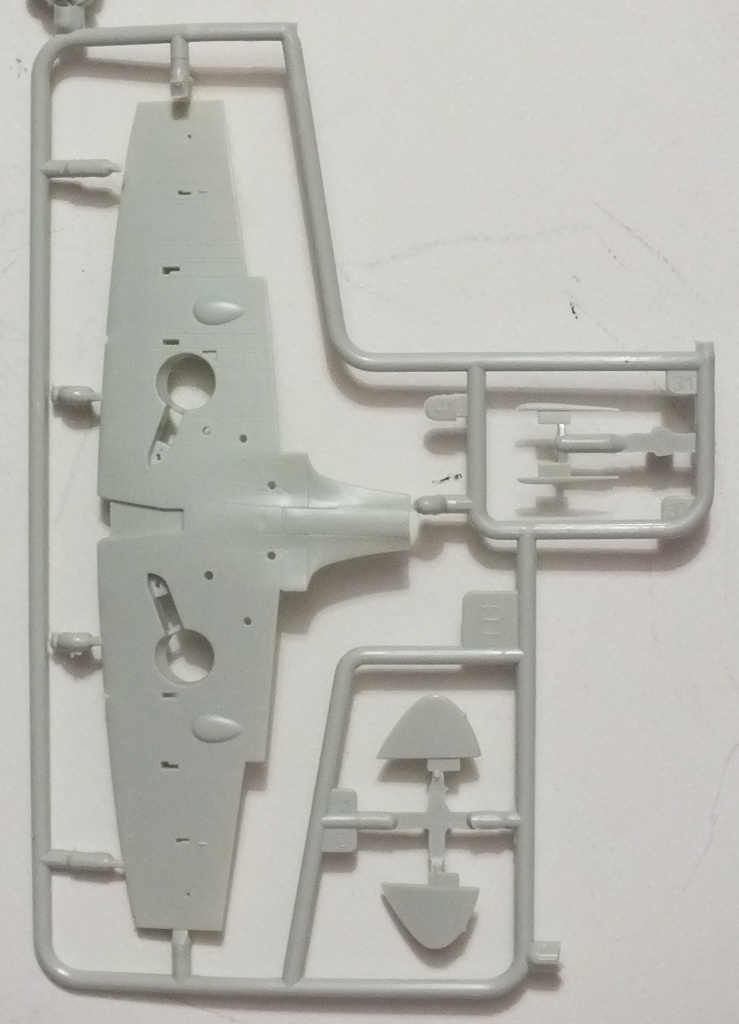


There is a little flash but the detail, and particularly the external surface detail, looks sharp but quite subtle and very nicely done.

The cockpit looks reasonably well detailed (though I’m not certain it’s entirely accurate – the cockpit floor in the original is curved, not flat as it is here, for example) and it includes interior detail inside the fuselage halves, though this isn’t particularly sharply moulded.

A single transparent sprue includes the sliding part of the canopy as a separate part and two alternate windscreens, one armoured and one unarmoured, though I believe that almost all Mk Vbs were fitted with the armoured version.
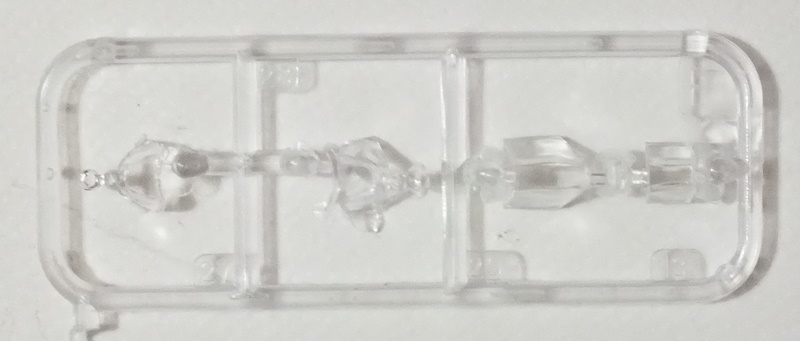
I have seen criticism of this kit elsewhere claiming that the moulding for the canopy, and particularly the sliding part, is much too thick. It may be a little thick, but I can’t say that it looks too bad to me and I certainly appreciate the option to be able to show the canopy in the open position.

I have also seen several other reviews that complain that the fuselage underside on this kit, where it joins the trailing edges of the wings, is moulded flat and lacks the distinctive “gull-wing” shape of the original. All I can say is that on the example I have, this area is not flat and appears to include the correct subtle curves.

The wingtips are provided as separate parts, and the instructions suggest that you can build this as either a standard or clipped-wing version. Clipped-wing Vbs were said to have better low-level performance, although this also degraded their climb ability. I appreciate having that option, though I believe that only the elliptical wing is correct if you’re going to use the supplied decals. Two under-fuselage slipper fuel tanks are also provided, one the 30 gallon version and the other the 80 gallon. The decal sheet is printed in-register and seems pretty comprehensive, including both the instrument panel and Sutton harnesses. The only things missing are the yellow patches for the leading edge of the wings which will need to be painted, which is a bit of a pain.

The instruments are also moulded into the panel, so you’ll probably want to sand this flat if you decide to use the supplied decal. The decals and suggested colour scheme only cover a single aircraft, flown by Squadron Leader Jan Zumbach of 303 Kosciuszko Polish Fighter Squadron (though there is no shortage of alternate aftermarket decals in 1/72 for the Mk Vb if you do want to depict a different aircraft). The colour scheme shown is correctly based on the RAF Temperate Day Fighter Scheme introduced in August 1941, comprising a camo scheme of Ocean Grey and Dark Green on top and Medium Sea Grey on the undersides. The suggested colours for the camo scheme (Dark Green and Blue-Gray) look just about OK though the colour suggested for the undersides, Medium Grey, looks a little dark.

The instructions seem to be up to Revell’s usual high standards and appear simple to follow.

Would You Want One?
I have seen a number of criticisms of this kit elsewhere. OK, I accept that it isn’t perfect, but I don’t think it’s terrible as a budget kit either. Many people mention the overly thick canopy, though it looks useable to me. One thing I would agree with is that the spinner looks a little short here and the propellor seems to be mounted too far to the rear, though I suspect it may be possible to address this. The exhausts also have round outlets rather than the more flattened openings found in the Vb. I think both these issues are because of the use of parts copied from the earlier Revell Spitfire Mk IIa kit from 2016 – I guess that this re-use of existing parts probably reflects the low price of this kit. Several people have also remarked in reviews that this kit lacks the distinctive “gull-wing” shape of the rear fuselage underside between wings, mentioning specifically that the fuselage underside between the trailing edges of the wings is shown flat in this kit. Mine certainly isn’t like that so I’m not sure if this kit has been revised since its first release? Overall and out-of-the-box I’m fairly happy with the level of detail and accuracy that I see on this budget kit.
If you don’t fancy this one, as you’d guess, there are lots of alternatives in 1/72, but few provide a really accurate kit of the Spitfire Mk Vb. Airfix do a Spitfire Mk Vb in 1/72, but it isn’t a new tool kit like their Spitfire Mk Ia from 2010: despite the new box-art it’s an original release from 1975. That said, it isn’t at all bad (the spinner and propellor, for example, are notably more accurate than on this Revell kit), though it does have some other accuracy issues. Tamiya also do a 1/72 Spitfire Mk Vb that was first released back in 1993 and it’s a decent kit, though unusually for Tamiya it has a one-piece canopy moulding that can’t be shown open, the wings lack dihedral and the shape of the rear fuselage looks not quite right.

Heller released a 1/72 Spitfire Mk Vb in 1978, and again it’s not bad (the cockpit is particularly good) but it has some problems with the wings which look really odd from the front. This kit has been also re-boxed by Aurora and Testors and is currently available from SMER Hi-Tech. Italeri also offer a Spitfire Mk Vb in 1/72. This was released in 2006, but it’s mainly based on a much earlier Spitfire kit from Italeri and it’s sort of OK, but not wonderful and the shape of the forward fuselage looks a little odd. HobbyBoss do a 1/72 Spitfire Mk Vb/Trop in their “Easy Assembly” series, and it isn’t bad in terms of overall look, but it lacks detail: the cockpit is very basic and it lacks landing gear doors, for example.
I suppose you could combine the best elements from this Revell offering plus bits and pieces from the Airfix and Heller kits to produce something more accurate. Alternatively, AZ Model from the Czech Republic released a 1/72 Spitfire Mk Vb in 2010 (though this seems also to be sold under the Kovozávody Prostejov logo), and reviews suggest it’s pretty good, though perhaps a little tricky to build. Overall, the AZ Model kit seems to be the most accurate Mk Vb currently available in 1/72 though as I haven’t seen this kit, I can’t say whether it is really the “definitive” Mk Vb as some people claim.
Related PostsRevell 1/72 Spitfire Mk Vb (03897) Build Review – coming soon


Not really a Spit fan, and really anything is bette than Airfix these days. Looks like if you can find a reality newer Revell they have stepped up their game. Time to see what else they have redone! Thanks for the insightful “unboxing”!
LikeLike